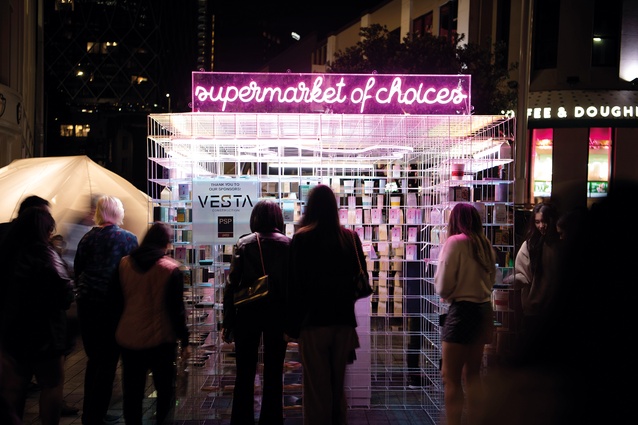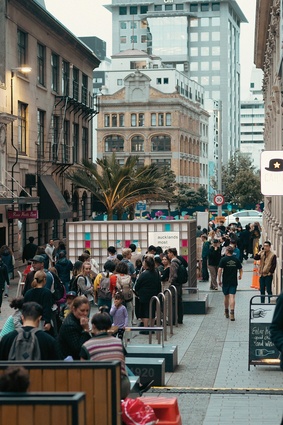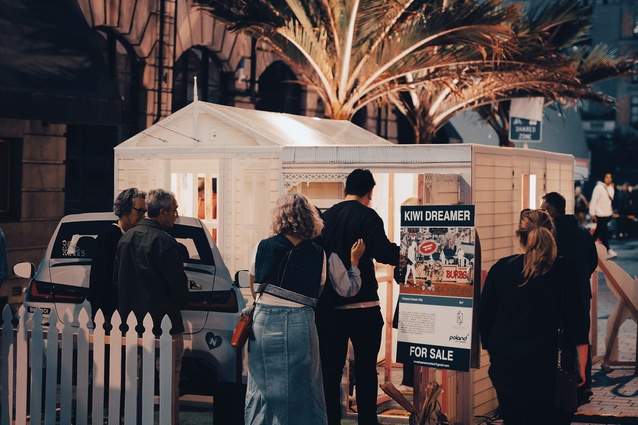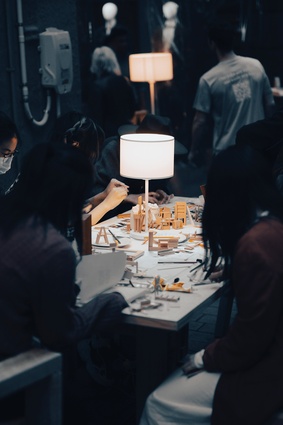Exhibition: Urban Art Village
Thursday 13 October 2022
Freyberg Place, Auckland
It was 5:45pm Thursday at Freyberg Place, downtown Auckland. Catchy segments of audio from synchronised drag and K-pop dance performances reverberated up Isthmus’ One Hundred and Eighty-nine Steps. One of many events taking place that evening as part of ‘Late Night Art’, the ‘Urban Art Village’ occupied O’Connell Street with a series of nine installations designed and built by coalitions of adventurous minds from the University of Auckland’s School of Architecture and Planning. The structures exuded a sense of playful discontent: discontent towards tertiary education, consumption practices, working conditions and housing precarity.
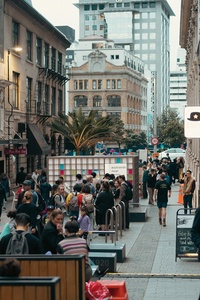
Nearby, urban art MVP Matt Liggins idled in his ‘Friendship Waka’, a modded Toyota Vanguard in which passengers were taken on stationary tiki tours via a projector screen mounted to the wagon’s windshield. Point-of-view fly-throughs from skydivers, roller coasters and hot wheels cars provided a disarming but fitting opening to an event that was equally as sincere as it was satirical.
Up next was ‘The Supermarket of Choices’, a neon-clad rebar mesh structure by fourth-year master’s students Anson Sieu, Kinki Lo, Evan Zhang and Johnny Jiang, which invited bystanders inside to help themselves to a range of products, in an effort to encourage discussion around consumer choices often not encountered at the checkout.
The event drew a swarm of spectators. Fellow students, jaded architecture grads and unsuspecting pedestrians on their way home from work were all caught up in the folds of the various projects. Outside the shelter of the university, the structures and their makers encouraged interaction.
‘WHO AM I?’ by Madeline Brown, Betty Han and Reiden Le’Jan Purificacion invited viewers to reflect on and locate their whakapapa. Social dreamer Maxine Goon’s ‘This is an Education Emergency’ was housed within a hi-vis tarpaulin-clad worksite. Participants had to pause and respond to the question: “What does architecture mean to you?” Here, the University of Auckland architecture students played the roles of sociopolitical designers — often facilitating and soliciting engagement from passers-by.
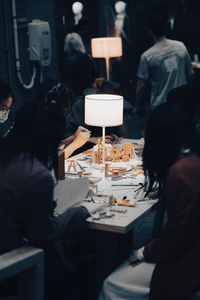
‘The Chairs in the Room, Quiet Beside the Elephant’ by Jack Wu, Oliver Ray Chaudhuri, Dianwang, Calvin Feng, William Chen and Binh Minh Ha provided a quick reprieve from the bustling crowds — inviting participants to build their own miniature chairs, UHU and all. Lashed to the stone bollards was ‘Undocumented Objects’ by Phillip Lee and Yeri Lee: the most site-specific of the works, which aimed to give agency to those often undocumented within the urban realm. Meanwhile, ‘Auckland’s Most Boring Office’ by Norm Dines, Gus Clelland and Cindy Zhang acted as a confessional cubicle for those with the post-work blues.
I often suspect that the majority of critical architecture discourse is absent from the public’s view, relegated to academic backbenches or for fleeting moments on our feeds. The Urban Art Village was full of playful reminders of the value of these types of critical practice in instigating and encouraging discussion with and within the public realm.
The installations were unabashedly of the present. Exaggerated or intentionally distorted and pixelated, the works opted to toy with contradictions rather than shun them. A stark reminder of this was ‘Kiwi Dreamer’ by Karl Poland, Robbie Anderson and Shelley Jiao: a cunning cultural commentary on the ‘nightmare reality’ of the quarter-acre section. Like many of the structures of the village, it would go on to reverberate further online. ‘Housing Bubble’ by Gujin Chung, Yifan Liu and Yilin Liu addressed similar issues on a macro scale, the rise and fall of the billowing bubble echoing the uncanny stream of wide-angle real estate interior shots housed within.
While siloed architectural protest and rebellion flows freely and fruitfully down our feeds, tangible disruptions such as these offer a more approachable and palatable way for the public to engage in these aspects of architecture, re-enchanting downtown Auckland through collaborative architectural practice.

